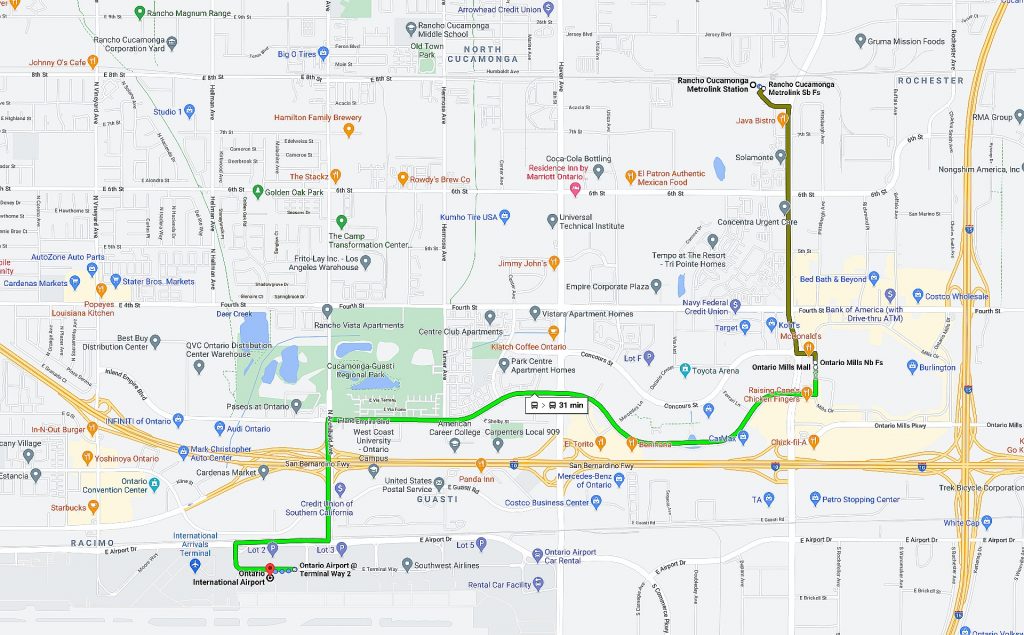The Boring Company’s underground tunneling projects are widely-appealing to Transit Departments and Authorities across the United States. Because of the sustainable tone of Elon Musk’s Boring Company, along with the efficiency of an Express-based system, agencies responsible for solving the issue of public passenger transportation are considering underground options more often than ever before. Above-ground public travel options, like Monorails or buses, are being ditched for underground options, and subways are outdated and not widely considered by these agencies.
Elon Musk’s underground tunneling venture has made it from California to Las Vegas, and now, back to California again, as the San Bernardino County Transportation Authority (SBCTA) is considering a new underground tunneling project from the Boring Company. Later today, on February 3rd, the entity will consider the Boring Company’s submission for an underground tunnel that would take travelers from several different locations to the Ontario International Airport, located in Southern California. While the Boring Company has already received the equivalent of preliminary approval from the Transportation Authority, more questions are being asked to secure the tunnel’s place in the densely-populated and traffic-heavy area of Southern California.
In September 2020, the SBCTA Board of Directors approved the release of a Request for Qualifications, seeking qualified entities to submit a Statement of Qualifications for a potential tunneling project in San Bernardino County. According to documents released by the SBCTA, the tunnel will run from the Rancho Cucamonga Metrolink Station to the Ontario International Airport, procuring a design-build and transitional operate-maintain methodology that will have the two transit systems running concurrently to complement one another.

The only thing is, not many companies with expertise in tunneling stepped forward. And by not many, only one did: The Boring Company.
The SBCTA wrote:
“In response to the RFQ, one Statement of Qualifications (SOQ), from The Boring Company, was received on November 30, 2020. A review panel was assembled involving a technical review team and an executive oversight team consisting of representatives from the City of Rancho Cucamonga, the City of Ontario, the OIAA, Omnitrans, and SBCTA. The SOQ was deemed responsive and passed all the minimum requirements of the RFQ.”
After an initial assessment from SBCTA Board Members, the Boring Company met the minimum requirements to qualify for further scrutiny. The Boring Company’s Statement of Qualifications only received a score of 58/100. Still, more information regarding financing, timing, ridership, and how the system will operate in conjunction with the Rancho Cucamonga Metrolink Station will likely increase that score. These issues are set to be brought up during the Board of Directors meeting later today.
DITCHING ABOVE-GROUND SYSTEMS FOR UNDERGROUND TUNNELS
Above-ground systems of transportation have been around for ages. Monorails, trains, and other large-scale passenger transportation systems have been aligned with cost-effective and efficient travel for decades, but a new era has come in thanks to Elon Musk. While many argue that the Boring Company’s system is a simple revision of a subway, it is far from identical. The Boring Company loops use Tesla’s all-electric vehicles for passenger transport, eliminating jam-packed, unsanitary, and oftentimes, uncomfortable situations where underground travel is offered.
Sitting in an automotive seat, likely joined by colleagues, or in some cases, complete strangers, is much more comfortable in a smaller setting, especially as the COVID-19 pandemic rolls on. Additionally, the express-system eliminates the need for unneeded stops, decreasing total travel time.
While the San Bernardino project seems to indicate that the Boring Company will work with an already-operational monorail system, other projects have completely abandoned the idea of using an above-ground Monorail system. One of the most notable is the Boring Company’s Vegas Loop. After the Las Vegas Convention and Visitors Authority (LVCVA) purchased the bankrupt Vegas Monorail system in 2020, it opened the door for the Boring Company to expand its possible tunneling to property exclusive to the Monorail.
The Boring Company has several other large-scale projects in the proposal stage, including one in Fort Lauderdale, Florida, and Chicago, Illinois. These projects are in the early stages and will be subjected to the speed at which local authorities move. Some agencies are quicker to get the ball rolling on public transit projects than others. For example, a tunnel between Baltimore and Washington D.C. would eliminate the need to travel on the Maryland Transit Authority’s Lightrail system, a cost-effective, but not time-effective, way to travel from suburbs of Baltimore County to the Nation’s Capitol. This project has been in a stalemate for several years but would expedite the travel time from Baltimore’s Camden Yards, home of the Orioles, to Washington. The Boring Company’s website indicates that an environmental review is pending.
Underground tunnels may be the way of the future, much like electric cars. At the forefront, a South African-born entrepreneur named Elon Musk is leading the charge, changing how human beings will travel from one point to another.
The San Bernardino County Transportation Authority’s Agenda is available here, with The Boring Company’s consideration beginning on page 13.
Original Publication by Joey Klender at Teslarati.




